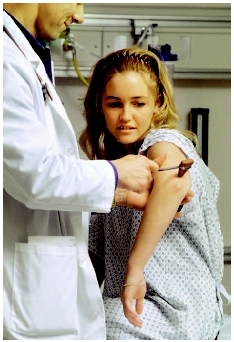Reflex tests
Definition
Reflex tests are simple physical tests of nervous system function.
Purpose
A reflex is a simple nerve circuit. A stimulus, such as a light tap with a rubber hammer, causes sensory

Reflex tests measure the presence and strength of a number of reflexes. In so doing, they help to assess the integrity of the nerve circuits involved. Reflex tests are performed as part of a neurological exam, either a mini-exam done to quickly confirm integrity of the spinal cord or a more complete exam performed to diagnose the presence and location of spinal cord injury or neuromuscular disease.
Deep tendon reflexes are responses to muscle stretch. The familiar knee-jerk reflex is an example; this reflex tests the integrity of the spinal cord in the lower back region. The usual set of deep tendon reflexes tested, involving increasingly higher regions of the spinal cord, are:
- ankle
- knee
- abdomen
- forearm
- biceps
- triceps
Another type of reflex test is called the Babinski test, which involves gently stroking the sole of the foot to assess proper development of the spine and cerebral cortex.
Description
The examiner places the person in a comfortable position, usually seated on the examination table with legs hanging free. The examiner uses a rubber mallet to strike different points on the individual's body and observes the response. The examiner may position, or hold, one of the limbs during testing, and may require exposure of the ankles, knees, abdomen, and arms. Reflexes can be difficult to elicit if the person is paying too much attention to the stimulus. To compensate for this, the person may be asked to perform some muscle contraction, such as clenching teeth or grasping and pulling the two hands apart. When performing the Babinski reflex test, the doctor will gently stroke the outer soles of the person's feet with the mallet while checking to see whether the big toe extends out as a result.
Risks
Reflex tests are entirely safe, and no special precautions are needed.
Normal results
The strength of the response depends partly on the strength of the stimulus. For this reason, the examiner will attempt to elicit the response with the smallest stimulus possible. Learning the range of normal responses requires some clinical training. Responses should be the same for both sides of the body. A normal response to the Babinski reflex test depends upon the age of the person being examined. In children under the age of one-and-a-half years, the big toe will extend out with or without the other toes. This is due to the fact that the fibers in the spinal cord and cerebral cortex have not been completely covered in myelin, the protein and lipid sheath that aids in processing neural signals. In adults and children over the age of one-and-a-half years, the myelin sheath should be completely formed, and, as a result, all the toes will curl under (planter flexion reflex).
Parental concerns
Parents should expect reflex tests to be included in every examination given to their children by a doctor or other healthcare provider. Reflex tests present no risks. Parents should only be concerned when they are told of abnormal reflex test results.
KEY TERMS
Babinski sign —Dorsiflexion (curling) of the big toe on stimulating the sole of the foot.
Neuron —The fundamental nerve cell of the nervous system.
See also Neonatal reflexes .
Resources
BOOKS
Bickley, Lynn S., and Peter G. Szilagyi. Bates' Guide to Physical Examination and History Taking , 6th ed. Philadelphia: Lippincott Williams & Wilkins, 2004.
Jarvis, Carolyn. Physical Examination and Health Assessment , 4th ed. Amsterdam, Netherlands: Elsevier, 2003.
LeBlond, Richard F., and Donald D. Brown. DeGowin's Diagnostic Examination , 8th ed. New York: McGraw-Hill, 2004.
Simel, David L. "Approach to the Patient: History and Physical Examination." In Cecil Textbook of Medicine , 22nd ed. Edited by Lee Goldman et al. Philadelphia: Saunders, 2003, pp. 18–22.
PERIODICALS
Berilgen, M. S., et al. "Effects of epilepsy on autonomic nervous system and respiratory function tests." Epilepsy and Behavior 5, no. 4 (2004): 513–6.
Calancie B., et al. "Tendon reflexes for predicting movement recovery after acute spinal cord injury in humans." Clinical Neurophysiology 115, no. 10 (2004): 2350–63.
Lefaucheur, J. P., and A. Creange. "Neurophysiological testing correlates with clinical examination according to fiber type involvement and severity in sensory neuropathy." Journal of Neurology, Neurosurgery, and Psychiatry 75, no. 3 (2004): 417–22.
Mold, J. W., et al. "The prevalence, predictors, and consequences of peripheral sensory neuropathy in older patients." Journal of the American Board of Family Practice 17, no. 5 (2004): 309–18.
Nadler, M. A., et al. "Cutaneomuscular reflexes following stroke: a 2-year longitudinal study." Journal of the Neurological Sciences 217, no. 2 (2004): 195–203.
ORGANIZATIONS
American Academy of Family Physicians. 11400 Tomahawk Creek Parkway, Leawood, KS 66211–2672. Web site: http://www.aafp.org/.
American Academy of Neurology. 1080 Montreal Avenue, St. Paul, MN 55116. Web site: http://www.aan.com/.
American Academy of Pediatrics. 141 Northwest Point Blvd., Elk Grove Village, IL 60007–1098. Web site: http://www.aap.org/default.htm.
American Academy of Physical Medicine and Rehabilitation. One IBM Plaza, Suite 2500, Chicago, IL 60611–3604. Web site: http://www.aapmr.org/.
American College of Emergency Physicians. PO Box 619911, Dallas, TX 75261–9911. Web site: http://www.acep.org/.
American College of Physicians. 190 N Independence Mall West, Philadelphia, PA 19106–1572. Web site: http://www.acponline.org/.
American College of Sports Medicine. 401 W. Michigan St., Indianapolis, IN 46202–3233. Web site: http://www.acsm.org/.
International Brain Injury Association. 1150 South Washington St., Suite 210, Alexandria, VA 22314. Web site: http://www.internationalbrain.org/.
WEB SITES
"Moro reflex." MedlinePlus. Available online at http://www.nlm.nih.gov/medlineplus/ency/article/003293.htm (accessed December 22, 2004).
"Neuro-Ophthalmologic Disorders." The Merck Manual. Available online at http://www.merck.com/mrkshared/mmanual/section14/chapter178/178b.jsp (accessed December 22, 2004).
L. Fleming Fallon, Jr., MD, DrPH
Comment about this article, ask questions, or add new information about this topic: